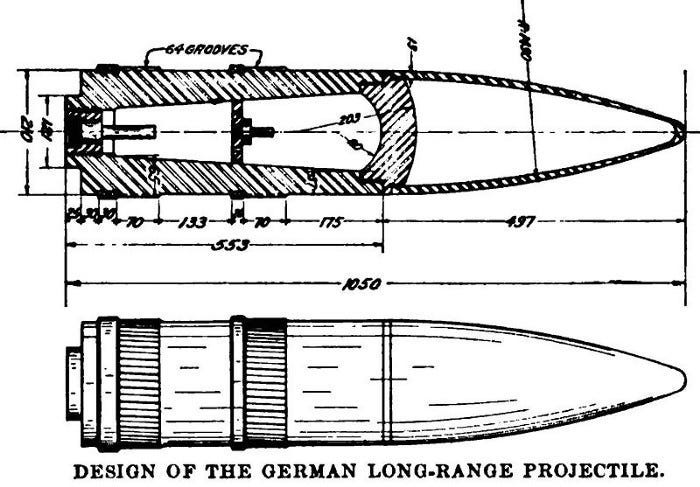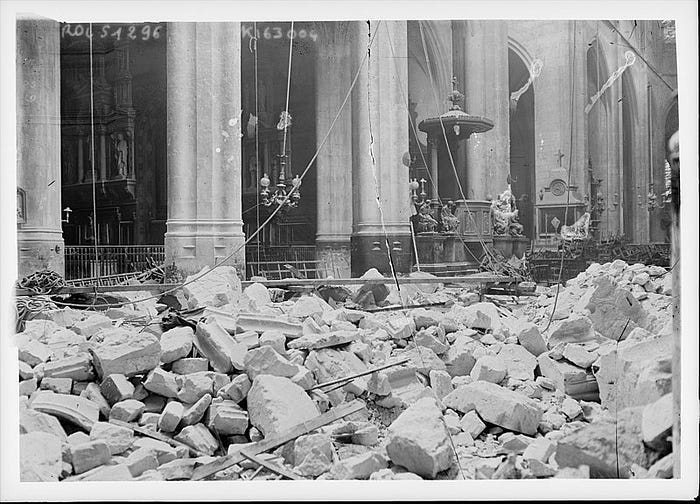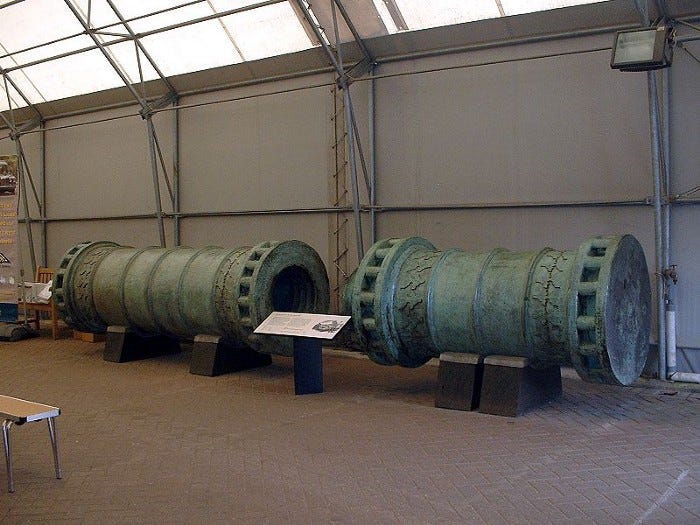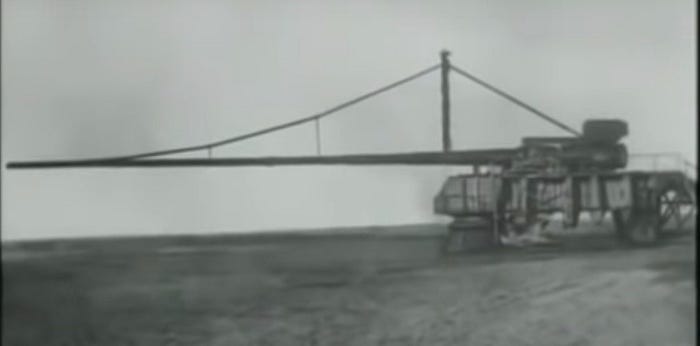Mankind Launched The First Object Into The Stratosphere In 1918
The curvature of the earth affected its trajectory, killing one hundred
Paris Gun Shell — No Artist Named [Public domain]
Traveling into and through the upper atmosphere is a relatively new technology for us, so it’s still in its exciting courtship phase. After all, as a species we’ve only been doing this since the times of the Cold War.
However, that isn’t exactly correct. What if I told you the first man-made object was launched into the stratosphere during World War I? What’s more, this object happened to be an artillery shell, not a rocket. Impossible? Well, not exactly. Germany did produce a weapon capable of firing a shell this high in 1918.
So, at a time when the horse was the most common form of transportation, mankind could fire a shell so high the curvature of the earth had to be accounted for. It sounds unbelievable for society at the time but think again. Mankind has been theorizing about launching things into space for centuries, some even going to the moon.
The Event
St-Gervais-et-St-Protais Church Struck By A Shell in 1918 — Wikimedia Commons [Public Domain]
On March 21, 1918, an explosion shook the city of Paris. It was followed by others in intervals of about fifteen minutes.
Onlookers could see no origin of what caused the explosion. There were no airships or artillery pieces in the vicinity. World War I was still going full steam, but the Germans were far from Paris. Their nearest position was about seventy-five miles away.
The bombardment continued with the most serious strike occurring eight days later. A shell landed on the roof of the Church of Saint-Gervais-et-Saint-Protais during a crowded Good Friday service. About 100 people were killed by falling debris and masonry.
Afterwards, it was found that no air ship was responsible for these falling shells. They were fired by a gun. Obviously, this startled Parisians because the largest guns of the time only had a range of near twenty miles. Suddenly no one was safe.
According to the documentary The Paris Gun — 238 mm City Destroyer, citizens of Paris began to panic and sent their children out of the city.
Large Guns Were Nothing New
The Dardanelles Gun — Wikipedia Creative Commons via Gaius Cornelius [Public domain]
“This darkness… showed that the projectile has passed the atmospheric strata, for the diffused light spread in the air would have been reflected on the metal walls, which reflection was wanting. This light would have lit the window, and the window was dark. Doubt was no longer possible; the travelers had left the earth.”
― Jules Verne, “From the Earth to the Moon” (1865)
One of the first instances showing the power of a large gun occurred in 1453 when the Ottomans knocked down the unbreakable walls of Constantinople. One massive brass cannon was twenty-seven feet in length and was reported to have been carried by a team of sixty oxen when disassembled. The Dardanelles gun pictured above is based on the design used for the super cannons that fired on the former Byzantine capital.
Isaac Newton also theorized about creating a powerful gun that could fire a cannonball into space in his 1687 Principia Mathematica. His theory involved sitting this cannon on a massive mountain to help defy his precious gravity.
Likewise, the grandfather of sci-fi Jules Verne wrote about a future where men could be fired to the moon. In his 1865 novel “From Earth To The Moon”, an arms manufacturer creates a giant cannon that could shoot a hollow shell carrying passengers to our celestial outpost. So, the idea of firing a projectile outside of the earth and mammoth-sized guns wasn’t totally unheard of.
“I have looked at the question in all its bearings, I have resolutely attacked it, and by incontrovertible calculations I find that a projectile endowed with an initial velocity of 12,000 yards per second, and aimed at the moon, must necessarily reach it. I have the honor, my brave colleagues, to propose a trial of this little experiment.”
— Jules Verne, “From the Earth to the Moon”
The Weapon
Okay, I might have misspoken a bit at the beginning of this article. The Germans didn’t have a gun that could fire seventy-five miles in 1918.
They had three of them. These massive cannons were made from three naval gun barrels welded together and each gun weighed 154 tons. They sat in a cradle that weighed twenty-six tons itself. The railway wagon that carried it was 210 tons.
Paris Gun Being Assembled (before 1918) — Picture From Astronautix.com
According to Popular Mechanics the cannons fired a 265 pound projectile twenty-five miles into the stratosphere. It took 170 seconds for the shell fired to reach Paris, which was approximately seventy-five miles away.
According to an article in the UK’s Independent, this human-sized shell was the first manmade object to reach this height. However, this created an interesting benefit and problem.
Major Arthur F. Cassels in his 1918 article in the Field Artillery Journal points out as the shell flies higher, resistance decreases adding to ballistic efficiency. Cassels says:
“The modern elongated projectile, with its long tapering head, has great ballistic efficiency, because of its good shape and heavy weight for any given diameter. Then, if we give it a sufficient initial velocity, and project it from a gun at a high angle of elevation, it will reach the upper strata of the atmosphere — and as the air becomes rarefied, so in proportion does the ballistic efficiency increase. For any given caliber of well-designed projectile, there is a certain height above the ground at which point the effect of the air resistance becomes negligible and the ballistic efficiency for all practical purposes infinite.”
However, he also indicates the rotation of the earth causes issues at those heights. According to NASA, this Coriolis Force can cause an object’s trajectory to curve because the earth doesn’t rotate at a uniform speed.
The farther north or south you go from the equator, the slower the earth spins. In other words, it’s difficult to fire your German shell in a straight line — it tends to curve off course. A clever NASA illustration demonstrates the theory below.
NOAA SciJinks Website Coriolis Force Illustration (Blue Train Is The Equator) — Public Domain
Just the physical size and power of the cannon created other mechanical problems. Popular Mechanics explains that 400 lbs. of gunpowder was needed to fire a shell. As you can imagine, this would cause an incredible shock.
This took an immediate toll on the gun barrel. Each shell fired in progression had to be slightly wider than the shell before. So, the barrels needed to be re-bored after twenty shots.
How Effective Was It?
The Paris Gun On Its Railway Cart — Screen Capture From Documentary “The Most Colossal Gun Ever”
Despite the incredible engineering feat of its creation, the Paris Gun was limited in its effectiveness. The Germans hoped this cannon would be a weapon that would bring their enemies to their knees. However, these guns never really had the intended effect.
The guns were only used from March through August of 1918. In that time period all three guns only fired 367 shells, resulting in 256 deaths. The shell that struck the church was responsible for over ninety of those deaths and likely not the intended target.
Also remember it could only be fired so many times before the barrels needed to be re-bored. Accuracy was also another issue. Major Cassels explains in his article that so many factors can influence the trajectory of a shell over seventy-five miles it would be hard to effectively calculate them all. Moreover, the walls of the shells fired had to be so thick only ten percent of the shell was dedicated to explosives.
Map Of Paris Showing Where Shells Landed — Picture By Catsmeat / Wikipedia Creative Commons
The picture above shows where shells landed in Paris between June and August. As you can see, they’re all over the map. Targeting one specific building or area with these guns was just about impossible.
Although the gun was limited in its effect, it’s understandable to see the panic it might have caused Paris. Having an unknown giant cannon dropping shells randomly on your home was likely terrifying. According to calculations by Major Cassels, the shells were traveling more than twice the speed of sound when they approached the ground. As a result, the victims likely never heard the shells coming.
The Germans destroyed all three of these guns before the war was over. The Allied powers never got to examine them personally. Most of the information about the guns was found in the files of German gun maker Krupp. The only thing the Allies did manage to get their hands on was a mounting for one of the guns.
French Postcard Showing The Paris Gun Mounting — Wikipedia Creative Commons
Resurgence Of The Giant Cannon
Despite the incredible tale, you likely think cannons of this magnitude are archaic and primitive. Rockets have won the day and are the technology of the future. Well, maybe. But the giant gun hasn’t been totally banished.
In an article Phys.org, scientist John Hunter describes his company Quick Launch, which intends to eventually build a “space gun”. This giant gun, which sits in the ocean, can fire certain cargoes into orbit assisted by a small booster. Hunter explains the gun can deliver items to orbit at $250 / lb. versus $5000 / lb. for a rocket.
The United States Army also has big plans for a giant cannon. According to Kyle Mizokami at Popular Mechanics, a new gun is being designed which has a range of 1,000 miles. The Strategic Long Range Cannon (SLRC) prototype is in the works, with a planned test date of 2024. Mizokami also explains how this technology could bring back the old-style battleship, changing the face of naval warfare.
While Elon Musk and his rockets may rule the present day, Jules Verne and his cannons haven’t been tossed away just yet. After all, they were the first to break into the stratosphere over 100 years ago. They may just have some other records left in them.
-Originally posted on Medium 12/6/20










